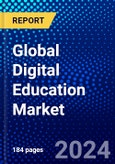The Global Digital Education Market is estimated to be USD 14.88 Bn in 2023 and is expected to reach USD 22.49 Bn by 2028 growing at a CAGR of 8.61%.The increased popularity of online courses acts as a catalyst for market development
Market Dynamics
Market dynamics are forces that impact the prices and behaviors of the Global Digital Education Market stakeholders. These forces create pricing signals which result from the changes in the supply and demand curves for a given product or service. Forces of Market Dynamics may be related to macro-economic and micro-economic factors. There are dynamic market forces other than price, demand, and supply. Human emotions can also drive decisions, influence the market, and create price signals.As the market dynamics impact the supply and demand curves, decision-makers aim to determine the best way to use various financial tools to stem various strategies for speeding the growth and reducing the risks.
Market Segmentations
- The Global Digital Education Market is segmented based on Learning Type, Course Type, End-Users, and Geography.
- By Learning Type, the market is classified into Instructor-Led Online Education and Self-Paced Online Education.
- By Course Type, the market is classified into Entrepreneurship and Business Management Courses and Science and Technology Courses.
- By End-Users, the market is classified into Academic Institutions, Enterprises, Government Organizations, and Individual Learners.
- By Geography, the market is classified into Americas, Europe, Middle-East & Africa and Asia-Pacific.
Company Profiles
The report provides a detailed analysis of the competitors in the market. It covers the financial performance analysis for the publicly listed companies in the market. The report also offers detailed information on the companies' recent development and competitive scenario. Some of the companies covered in this report are Alison, Edureka (Brain4ce Education Solutions Pvt. Ltd.), Coursera, Inc., Edmodo Company, Edx Inc., FutureLearn Company, etc., etc.Countries Studied
- America (Argentina, Brazil, Canada, Chile, Colombia, Mexico, Peru, United States, Rest of Americas)
- Europe (Austria, Belgium, Denmark, Finland, France, Germany, Italy, Netherlands, Norway, Poland, Russia, Spain, Sweden, Switzerland, United Kingdom, Rest of Europe)
- Middle-East and Africa (Egypt, Israel, Qatar, Saudi Arabia, South Africa, United Arab Emirates, Rest of MEA)
- Asia-Pacific (Australia, Bangladesh, China, India, Indonesia, Japan, Malaysia, Philippines, Singapore, South Korea, Sri Lanka, Thailand, Taiwan, Rest of Asia-Pacific)
Competitive Quadrant
The report includes Competitive Quadrant, a proprietary tool to analyze and evaluate the position of companies based on their Industry Position score and Market Performance score. The tool uses various factors for categorizing the players into four categories. Some of these factors considered for analysis are financial performance over the last 3 years, growth strategies, innovation score, new product launches, investments, growth in market share, etc.Ansoff Analysis
- The report presents a detailed Ansoff matrix analysis for the Global Digital Education Market. Ansoff Matrix, also known as Product/Market Expansion Grid, is a strategic tool used to design strategies for the growth of the company. The matrix can be used to evaluate approaches in four strategies viz. Market Development, Market Penetration, Product Development and Diversification. The matrix is also used for risk analysis to understand the risk involved with each approach.
- The publisher analyses the Global Digital Education Market using the Ansoff Matrix to provide the best approaches a company can take to improve its market position.
- Based on the SWOT analysis conducted on the industry and industry players, the publisher has devised suitable strategies for market growth.
Why buy this report?
- The report offers a comprehensive evaluation of the Global Digital Education Market. The report includes in-depth qualitative analysis, verifiable data from authentic sources, and projections about market size. The projections are calculated using proven research methodologies.
- The report has been compiled through extensive primary and secondary research. The primary research is done through interviews, surveys, and observation of renowned personnel in the industry.
- The report includes an in-depth market analysis using Porter's 5 forces model and the Ansoff Matrix. In addition, the impact of Covid-19 on the market is also featured in the report.
- The report also includes the regulatory scenario in the industry, which will help you make a well-informed decision. The report discusses major regulatory bodies and major rules and regulations imposed on this sector across various geographies.
- The report also contains the competitive analysis using Positioning Quadrants, the Proprietary competitive positioning tool.
Report Highlights:
- A complete analysis of the market, including parent industry
- Important market dynamics and trends
- Market segmentation
- Historical, current, and projected size of the market based on value and volume
- Market shares and strategies of key players
- Recommendations to companies for strengthening their foothold in the market
Table of Contents
Companies Mentioned
- Alison
- Edureka (Brain4ce Education Solutions Pvt. Ltd.)
- Coursera, Inc.
- Edmodo Company
- Edx Inc.
- FutureLearn Company
- Federica Web Learning
- Intellipaat Software Solutions Pvt. Ltd.
- Jigsaw Academy
- Kadenze, Inc.
- Khan Academy
- LinkedIn Corp.
- Linkstreet Learning
- NovoEd, Inc.
- Pluralsight LLC.
- Skillshare
- Telefónica Educación Digital
- Udacity, Inc.
- Udemy, Inc.
- XuetangX
Table Information
| Report Attribute | Details |
|---|---|
| No. of Pages | 184 |
| Published | February 2024 |
| Forecast Period | 2023 - 2028 |
| Estimated Market Value ( USD | $ 14.88 Billion |
| Forecasted Market Value ( USD | $ 22.49 Billion |
| Compound Annual Growth Rate | 8.6% |
| Regions Covered | Global |
| No. of Companies Mentioned | 20 |









